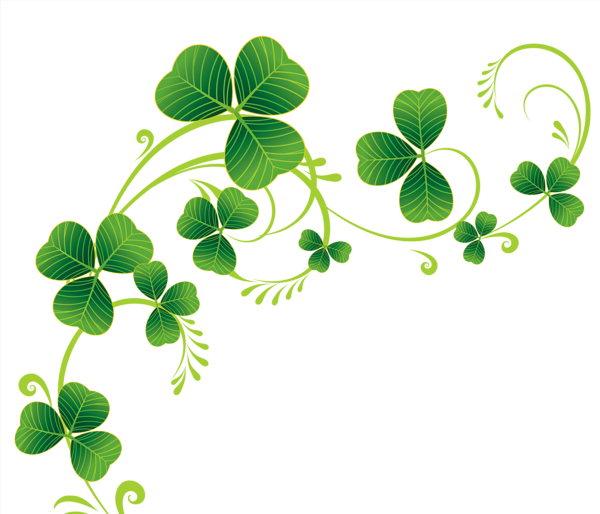 |
Parades are a major part of modern St Patrick's Day celebrations,
but how traditional are they? |
Today, St Patrick's Day (at least in the US) is that one day a year when everyone's Irish. Millions of Americans, regardless of whether they have Irish blood or not, celebrate by wearing green, drinking, watching parades, and carrying on in dozens of ways that the Roman missionary we're meant to be celebrating probably would not have understood. In Chicago, they even dye the river green, which really would have confused our ancestors.
The holy day devoted to a British saint has also managed to become a celebration of Irish nationalism, which is a cause for much confusion among those who don't know a lot of the history of this unusual holiday. And then there are the debates as to whether it's actually appropriate to wear any orange on St Patrick's day; some say we should be wearing "St Patrick's blue" instead, and then there are those who wear Scottish kilts and insist that it's really a celebration of all things Celtic. And then there are the food and beverage debates: corned beef and cabbage or Guinness beef stew? Green beer, Guinness, or whiskey cocktails? There's really no end to the confusion.
So how should one celebrate? That really depends largely on personal preference, but I'll try to explain the origins of the more common traditions here to help everyone make more educated choices about how they spend the day.
The Basics: Who, Exactly, Are We Celebrating?
The best place to start is with a little history. Who, exactly, are we celebrating, and was St Patrick actually English, as some claim? The second question is simpler to answer: no. St Patrick was likely born somewhere on the east coast of Great Britain, likely south of Hadrian's Wall (so not in Scotland*), and probably in north Wales, or near modern-day Liverpool. However, even if he was born in what is now England, he cannot have been English because the English did not exist yet.
The Angles and Saxons, who invaded the southern part of Great Britain in the 5th century and imparted their language, religion, and genes to many subsequent generations of English men and women, had not yet arrived on the island when St Patrick was born around 385 AD. Therefore he wasn't English. Furthermore, his parents were either Romans (from southern continental Europe- more likely French or Italian than English), or romanized Britons (Celts, from modern-day England or Wales, and culturally and genetically closer to the modern Welsh and Bretons than to the English).
All the accounts agree that St Patrick's father was a Roman official in the late 4th century. From there, we can infer that Patrick was from a fairly wealthy family, and that he was probably well educated. This also tells us that Patrick was almost certainly raised as a Christian, since the emperor Constantine had declared Christianity the state religion of Rome in 380 AD, a few years before Patrick's birth.
Genteel as Patrick's upbringing likely was (by Roman standards, anyway), the late 4th century was a difficult time for the Roman Empire. While the south had been shaken by civil wars, one of which had brought Constantine to power, the edges of the empire were beginning to crumble. Attacks by the Germanic tribes across the Rhine were becoming common, as were raids from Scotland (Alba to the Romans) and Ireland (confusingly called Scotia by the Romans, but that's a different can of worms I won't be opening just now).
Just like the Viking raiders a few centuries later, the Irish raiders of the 4th century were after anything of value, whether it be gold, livestock, or slaves. Patrick was captured in one such raid as a young teenager, and spent the next several years as a slave herding sheep somewhere in the north of Ireland, probably in county Armagh, Antrim, or Down. The legend goes that durring those several years alone with a bunch of sheep, Patrick started hearing the voice of God, and that the voice helped him to escape by stowing away on a ship transporting some Wolfhounds to Britain and on to the rest of the Roman Empire, where they were highly prized.
Now in his early twenties, Patrick, made much more pious by his experiences, began studying for the priesthood, possibly in Gaul (modern France), at which point, the voices came back. This time, Patrick believed he was being called to convert the Irish to his faith, so he rather bravely decided to become a missionary, a life choice likely to get you beheaded or burnt alive in the early 5th century. So Patrick set out for Ireland, willingly this time, and set about converting the population with the help of the local flora and fauna.
While Patrick did not convert the entire island overnight by banishing all the snakes (there weren't any to begin with), he was much more successful than could have been hoped. Patrick set up a church in Armagh and managed to convert many of the local tribes. The fact that he understood the culture and spoke the language was certainly helpful, and in this case at least, the process of conversion was quite peaceful, and tolerant of those who did not convert. Many pagan customs were retained, including the harvest festival Samhain, which became All Hallow's Eve, or Halloween, in the Christian tradition. These additions, plus the inherent Celtic love of learning, resulted in a distinctly Irish form of Christianity that would make the so-called Dark Ages after the fall of Rome much less dark in Ireland than elsewhere. Patrick is known to have advocated for peace between the warring tribes and small kingdoms of Ireland, with some success, and frequently spoke out against slavery, also fairly successfully. We also know that unlike most 5th century missionaries, St Patrick managed not to be martyred; his feast day on March 17 is said to be the date of his death (of natural causes, at a very advanced age) sometime in the mid 5th century.
So here we have an advocate for peace and champion of the oppressed who encouraged education and was very tolerant of other cultures. It's no wonder he's such a popular saint. He sounds like the sort of person a lot of politicians want us to think they are.
*Some sources say he was born near Dumbarton, Scotland, but most agree he was from farther south.
This Sounds Like a Religious Holiday. Is the Drinking Really Appropriate?
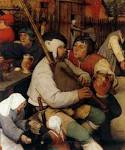 |
Note the enormous mugs of beer. Before John
Calvin ruined everyone's fun in the 16th
century, people partied a lot more than we do
today. |
If I had a dollar for every time someone said St Patrick would probably be rolling in his grave if he knew what we do in his honor every year… But really, those who think that celebrating every conceivable holiday by getting completely hammered is a modern phenomenon have clearly never seen a Bruegel painting. In fact, before the advent of Calvinism, the extremist Protestantism that gave us the Puritans, Methodists, and other religious groups who believed alcohol to be sinful beginning in the 16th century, almost every feast day involved outrageous amounts of drinking.
Realistically, the average medieval peasant could probably drink the average modern frat boy under the table. The medieval calendar was full of saint's days and other feast days, all celebrated with copious amounts of alcohol. St Patrick's Day will not have been any different in the middle ages, and late Roman era when the saint was alive will have been much the same. Christian or no, Romans were Romans, and very capable of out-partying us today. So feel free to drink as much as you want on the 17th. St Patrick probably did.
So How Did A Religious Holiday Become So Nationalist?
Well, this process began in the 18th century, when Irish soldiers in the British army would organize parades on this day to express their national identity. The predominantly Catholic and often Gaelic speaking Irish saw themselves as different from the British regiments they were serving alongside, and being Irish, they did their best to show it.
While in Ireland, St Patrick's Day remained a minor religious observance until the mid 20th century, Irish emigrants abroad, especially in North America, continued the tradition of taking advantage of their national saint's day to celebrate their heritage. This was partly because most 19th century emigrants felt that they had been forced out of their homes, whether by famine or poverty or religious persecution; the Gaelic word for emigrant really translates to "exile".
The nationalism took on new dimensions in the nineteen-teens and twenties, when Irish nationalist groups started raising money in the US to fund a war against the English (which they won in 1921). The nationalism has dropped off a bit as the holiday has become more of an excuse for anyone, Irish or not, to get very drunk, but it's still also an excuse for Irish Americans to show their pride.
The Great Color Debate: Green or Blue?
Around this time of year, any number of news sites will post a St Patrick's day article giving cursory explanations of a few traditions associated with the patron saint of Ireland, not unlike what you're reading right now. Many of those will almost gleefully point out that all the revelers out in green on the 17th are doing it wrong, and that the color traditionally associated with St Patrick is blue, not green. This confusion is likely the result of inadequate research and oversimplification.
It's true that the Order of Saint Patrick, created by the English in the 18th century as the highest chivalric order in Ireland, essentially equivalent to the Order of the Garter in England, wears blue, and that this blue is referred to as "St Patrick's blue" in many English and Anglo-Irish accounts. However, this tradition is of Anglo-Irish origin, and only dates from about 1780. (For those who don't know, the Anglo-Irish were the Protestant English ruling class imposed on Ireland beginning in the Tudor era in the 16th century.) Some 18th century accounts actually suggest that blue was chosen instead of green or orange because those colors already had the strong political associations they carry in Ireland today.
Furthermore, we have it from a few 17th century accounts that some Irish Catholics (whose holiday this was to begin with) were already wearing shamrocks and green rosettes on St Patrick's Day then, and the practice was certainly widespread by the 19th century, when it was documented on both sides of the Atlantic. In other words, the "wearin' o' the green" actually predates "St Patrick's Blue." So as far as I with my Irish Catholic heritage am concerned, green is more correct than blue, especially given the nationalist dimensions of this holiday, but if you happen to know that your Irish ancestors were Anglos (unlikely- they weren't starved out during the famine), blue might be the more appropriate choice for you, but expect to spend the day explaining yourself, and probably being pinched. Most ordinary party-goers aren't aware of the Anglo tradition, after all.
And as to Orange…
As you may have noticed, one third of the Irish flag is orange, but some people get very touchy about those who choose to wear green on St Patrick's Day. What is this all about?
Well, as I've discussed in much more detail
elsewhere, the British Parliament deposed the last of the Stuart kings, James II, for religious reasons in 1688. James was a Catholic, and therefore had a lot of supporters in Ireland, so he fled there after he was deposed and raised an army to try to get his crown back. The new king of England, James's Protestant son-in-law William of Orange, responded by invading. William was able to muster some support from the Scots-Irish, descendants of Presbyterian Scots who had been granted land in northern Ireland in an attempt at preventing future uprisings back in 1603, and who supported Protestant rule. Irish Presbyterians have been called "Orange" or "Orangemen" ever since in reference to their support of King William III ever since.
The Orangemen have always supported English rule in Ireland. When the nationalist movement began to gain momentum in the early 20th century, the Orangemen opposed it, and even went so far as to raise their own volunteer force to fight against the IRA during the Anglo-Irish War (1918-21). They are represented in the Irish flag (adopted by the rebels in the Easter 1916 Rising) in an attempt at reconciliation: the green represents Gaelic tradition, orange for the Orangemen, and white for peace between them.
That peace has been elusive, and the religious division has politically divided the island. The vast majority of Irish Presbyterians are still in the northeast, the bit of the island still under English rule, where they account for slightly more than half the population. Yet less than one quarter of the population of the entire island is Presbyterian, and in the independent Republic of Ireland, they are less than 6% of the total, while 87% are Catholic and the majority of Protestants are Anglican.
Realistically, there aren't very many "Orange" Irish, and they certainly wouldn't want to be represented on an Irish nationalist holiday- generations of Orangemen have fought against Irish nationalism. So if the orange in question is on, say, a Guinness t-shirt or an Irish flag scarf, by all means, wear it. If, however, you're trying to decide whether it's more appropriate to wear your orange shoes or your black ones, wear the black. We wear green on St Patrick's Day to support Irish nationalism, so the orange of the flag is fine, but if it's in just about any other form, it's the color of the opposition. It's a bit like wearing blue to the Republican national convention, only with a lot more beer.
And What's With the Kilts and Bagpipes? I Thought They Were Scottish.
 |
| Pipers in the New York St Patrick's Day parade. |
If you thought the kilt and the pipes were Scottish, you were absolutely right. They are. What you see above are pipers marching in the New York City St Patrick's Day parade. Note the bearskin (funny hat), fly plaid (piece that goes across the chest and over the shoulder), sporran (fluffy purse thing in front), and kilt. The uniform of this and most other pipe bands is actually borrowed from 18th and 19th century military uniforms, worn by the Highland regiments of the British army. And those uniforms were essentially a formalized form of traditional Highland dress (furry hats aside). All in all, that's rather an odd sight to see marching down a street in New York in honor of Ireland's patron saint, isn't it? Shouldn't they be wearing tweed jackets and Wellies?
The confusion here seems to date from the around the turn of the 20th century. At that time, the Gaelic League and other Irish nationalist groups set about trying to revive traditions that had been banned by the English centuries before. They learned the Irish language, used Gaelic spellings of names, and wrote down ancient myths and fairy tales. Some also started wearing kilts, on the assumption that what was traditional in (Gaelic) Scotland must also have been traditional in Gaelic Ireland. And while traditional dress was well-documented in Scotland, having only been banned from 1747-82, while it had been illegal in Ireland since the 16th century, and therefore less was known. What we do know about Gaelic dress in Ireland before the ban is that it generally involved a long linen tunic and some sort of cloak or blanket, often in checkered material. It's thought that late 19th and early 20th century readers confused this with the Scottish kilt and plaid, though in fact those evolved in Scotland out of a similar tunic-and-blanket sometime after the ban on Gaelic dress in Ireland. Whatever its origins, the tradition stuck in the US, and kilts are now everywhere on St Patrick's Day, and at Irish festivals all over the country.
So if you have a kilt, and you're dying to wear it, don't let the fact that it's not really Irish stop you. At worst, you're showing solidarity with your fellow Celts, and I promise the girls will love it. However, you really needn't spend the money (they're bloody expensive!) to show off your Irish heritage.
Bagpipes are another matter entirely. While the Great Highland pipes most modern pipe bands carry are the Scottish variety, bagpipes date at least to ancient Egypt, and have been common in Ireland for a few thousand years. what you usually see in Ireland, though, are the smaller uilleann pipes. They're not nearly as loud as the Highland pipes, and therefore more suited to playing indoors to an audience than they are to using on the battlefield. If you manage to find a properly traditional musical performance this weekend, chances are excellent you'll see someone play the uilleann pipes.
Enough About Fashion. Isn't This A Food Blog? What Should I Eat?
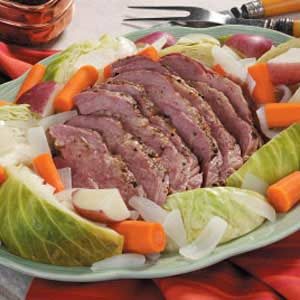 |
| Pictured: Not Actually Irish |
Well, the traditional St Patrick's Day meal is corned beef and cabbage, usually accompanied by potatoes. If you're interested enough to have sifted through my rants about color, you probably already knew that. What you might not have known, though, is that this dish, like most of the other common St Patrick's Day traditions in the US, originated in North America, probably in the 19th century. It's almost nonexistent in Ireland, where the closest equivalent is bacon and cabbage, though that has no particular association with this holiday. This holiday is traditionally celebrated with a family meal on both sides of the Atlantic, so just pick something something Irish, and enjoy! My personal favorites are beef and Guinness stew and Dublin coddle, one of which I'll try to post before the 17th.
Bangers and mash is also a good option, if a little less distinctly Irish. At the very least, I'd recommend toasting a slice of
Irish soda bread (or the
Irish American version) with your eggs and bacon that morning, before going out to the pub. You'll need something to absorb all the beer, after all!
And Speaking of Beer…
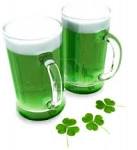 |
| Pictured: Even Less Irish |
Well, I should hope that drinking the horrifying green watery stuff isn't on your agenda, for starters. Granted, most of the American light beers that's made with could benefit from a little color, but I'd much rather it came from a darker malt, not from artificial coloring. Green beer is one tradition that's purely American, with no Irish roots at all. The beers used are almost always lagers, since they're light in color, which are German in origin, and only became popular in the US after prohibition.
If you do plan on making your own green beer at home, there is an Irish lager available in the US- Harp- though it's a bit more expensive than, say, Coors light. You could also go for a craft lager, which will also be more expensive than Coors or Bud. Just remember as you hand over the credit card that your taste buds will thank you later. Assuming you do go with a tastier beer, though, I wouldn't even bother with the food coloring. Just show off your good taste, instead. If you really prefer lagers, that is.
For the last generation or two, the best selling beers in America have been lagers, but this was partly due to a lack of much of anything else on the American market. From the end of prohibition until the 1980's or so, Guinness, Bass, and a few other Irish and British imports were among the very few ales available in the US, and they could be difficult to find. But as craft breweries began to spring up all over the country, and particularly in the west, America's palate began to change. In the last few decades, lagers have dropped in popularity while ales- defined as anything made with top-fermenting yeast, therefore ranging from pale ales to imperial stouts- have gained a much stronger following.
So if you think you don't like beer, but your only point of reference is the Miller Lite your dad buys or the PBR your roommate brought to parties in college, you may want to consider giving Guinness a try. You may find, like a lot of people have, that you just don't like lager. Or if Guinness is too dark for you, there are Irish red ales like Smithwick's and Kilkenny. They're less intensely flavored than stout, but they're more traditional, having been brewed since the 17th century, when stout emerged in the 18th.
Don't like ales either? Gluten-free? Allergic to hops? Well, there is one last option: cider. It's made from apples, so there's no gluten, naturally, without sacrificing any flavor. It's also native to the British isles- it's been brewed in Ireland for thousands of years- and it's associated with St Patrick, who some say planted apple trees in Ireland. It's sweet and refreshing, and comes in pints, which make it a perfect alternative to beer, especially for wine drinkers.
For more on Irish beers, as well as food pairings,
click here.
Last But Not Least: Spirits And Cocktails.
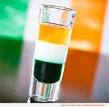 |
If you think think this
is traditional, you
haven't been paying
attention. |
You know all those green cocktails you see everywhere this time of year? Well, this will come as no surprise if you've read this far, but none of those are actually Irish. While cocktails have been around since the mid 19th century or so, mixed drinks have only just begun to catch on in Europe. They're certainly nowhere near as popular over there as they are in the US. This is a legacy of prohibition; while alcohol was illegal in the US, high quality spirits were difficult to come by, so mixing was a way of covering up the unpleasant taste of bathtub gin. Cocktails maintained their popularity after prohibition ended, and many Americans still prefer them to beer or wine. Therefore a cocktail has been devised for every occasion, and St Patrick's Day is no different. Green drinks abound, and while many of them undoubtedly taste better than green beer, they're no more authentic.
Of course, there
are genuinely Irish spirits, if that's your preference. Whiskey was invented in Ireland in the early middle ages (by monks, of course), and Ireland still produces some of the best whiskeys in the world. Irish whiskey has the double advantage of being less expensive and more approachable than Scotch, tending toward smoother, more vanilla-y flavors, though if you're used to Bourbon, Irish whiskey won't be as sweet. Traditionally, whiskey was drunk neat, or with a little water, though you'll find it in lots of mixed drinks today.
That's just a basic overview of some of the major St Patrick's Day traditions here in the US. There are plenty of others, but if I explained all of them in detail, you'd be reading this all weekend, which would defeat the entire purpose of this article. The whole point is to enable you to enjoy the holiday, however you choose to celebrate (and maybe impress your friends with some trivia). As the festivities kick off tonight and continue through Tuesday, I hope you enjoy pleasant weather for outdoor activities, good company and (of course!) good food and drink. Have fun, and be safe! Slainte!









